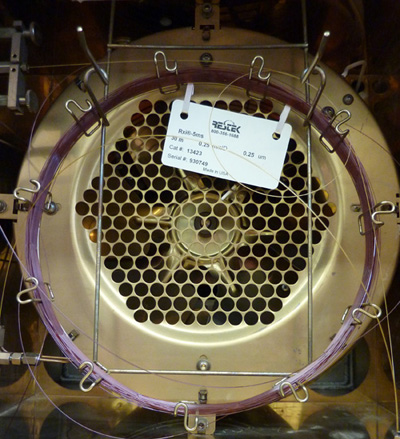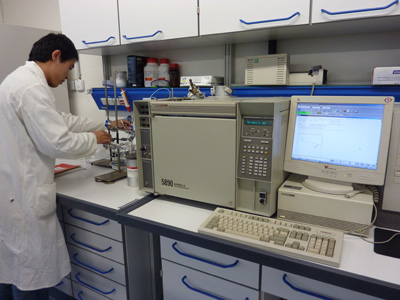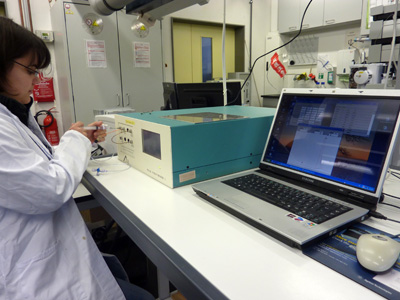Die Inhalte dieser Seite sind leider nicht auf Deutsch verfügbar.
Seitenpfad:
- Organische Geochemie
- Laboratories
- Gas chromatography
Hinrichs Lab - Gas chromatography
Introduction
GC techniques are an integral tool in the Hinrichs Lab. They enable the separation of organic molecules in the range from C1-compounds such as methane up to compounds containing a much higher number of carbon atoms such as archaeal biomarkers (up to 48 carbon atoms) or bacteriohopanepolyols (up to 35 carbon atoms). Moreover, our analytical facilities are capable to determine trace gas concentrations of inorganic compounds such as hydrogen, oxygen, nitrogen, and carbon monoxide or dioxide.
A classical GC is equipped with an autosampler and injection port (split/splitless – S/SL, on-column, or programmable temperature vaporizer – PTV), a capillary column for separation and a detection system. The basis for the separation are differences in volatility, i.e. boiling points, of organic compounds, and their interaction with the stationary phase of the capillary column and the mobile gas phase. By heating of the GC oven, organic compounds are moved along the capillary column and are detected one by one by the detector at the column outlet. There are dedicated GCs and detectors available in the Hinrichs Lab targeting either compounds containing oxidizable carbon atoms (flame ionization detector – FID), nitrogen- or phosphorous-containing organic compounds (nitrogen phosphorous detector – NPD), or gaseous inorganic compounds (reduced compound photometer – RCP; thermal conductivity detector – TCD; pulsed discharge detector – PDD). All of these detectors are dominantly used for quantification purposes whereas multiple universal mass spectrometry detectors are used in connection with GCs for the identification of organic and inorganic compound groups (see GC-MS).
A classical GC is equipped with an autosampler and injection port (split/splitless – S/SL, on-column, or programmable temperature vaporizer – PTV), a capillary column for separation and a detection system. The basis for the separation are differences in volatility, i.e. boiling points, of organic compounds, and their interaction with the stationary phase of the capillary column and the mobile gas phase. By heating of the GC oven, organic compounds are moved along the capillary column and are detected one by one by the detector at the column outlet. There are dedicated GCs and detectors available in the Hinrichs Lab targeting either compounds containing oxidizable carbon atoms (flame ionization detector – FID), nitrogen- or phosphorous-containing organic compounds (nitrogen phosphorous detector – NPD), or gaseous inorganic compounds (reduced compound photometer – RCP; thermal conductivity detector – TCD; pulsed discharge detector – PDD). All of these detectors are dominantly used for quantification purposes whereas multiple universal mass spectrometry detectors are used in connection with GCs for the identification of organic and inorganic compound groups (see GC-MS).


Thermo Finnigan Trace GC-FID
The single-channel GC-FID equipped with a PTV injector is located in our microcosm laboratory and is used for routine analysis of hydrocarbon gases. For example, we monitor the production or consumption of methane during our incubation studies of deep biosphere sediments. We also use this system on research cruises. Its sensitivity is in the low ppm range.


Hewlett Packard 5890 GC-FID/NPD
This GC system is equipped with a S/SL and an on-column injector and two detectors (FID and NPD). Its purpose is to measure biomarker lipids or C1-methylated compounds. To lower the detection limit of the latter to low- or even sub-micromolar levels, we are evaluating several pre-concentration and sample preparation techniques, including purge-and-trap, solid-phase microextraction, and desalting methods for direct aqueous injection.


Peak Performer 1 GC-RCP
With the single-channel GC-RCP containing a direct gas inlet, we analyze hydrogen at low ppb levels. The system is routinely used on research cruises aiming to investigate anaerobic biogeochemical processes from the deep biosphere and near gas seepage areas (hot vents or cold seeps). During incubation experiments, we monitor hydrogen gas concentrations over time.


